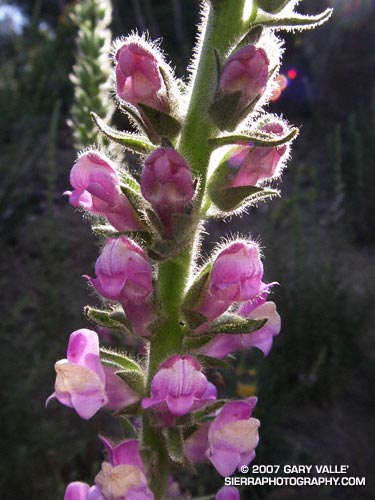
Rose snapdragon (Antirrhinum multiflorum) at Sage Ranch Park. From a run on May 14, 2007.

Rose snapdragon (Antirrhinum multiflorum) at Sage Ranch Park. From a run on May 14, 2007.
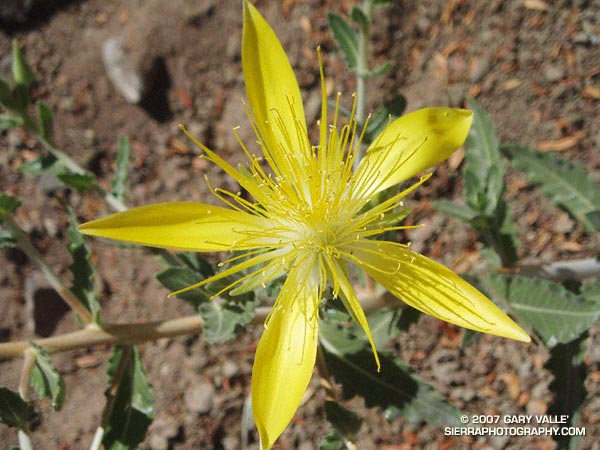
Blazing star,
Dancing shadows,
It looms above…
The Baldy Peaks 50K (currently in hiatus) is without a doubt the most challenging 50K I’ve done. This race climbs to the summit of Mt. Baldy twice, once from the village and once from Manker Flats. And after climbing Baldy twice, you get to amble over to Thunder Mountain as well. The total elevation gain (and loss) is reported to be 10,775 ft.
Race organizers asked endorphin influenced runners to write a poem on the second ascent of the peak.
This particular Blazing Star (Mentzelia laevicaulis) was on the Manzanita Trail, between South Fork Campground and Vincent Gap. In the Baldy Peaks race they were along the service road between the Notch and Manker Flats.
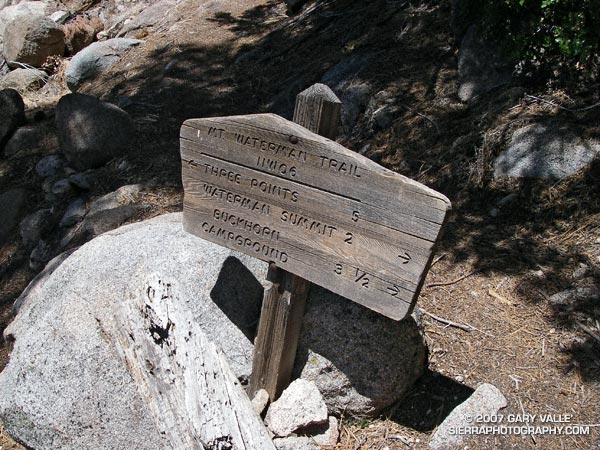
Five miles of (mostly) downhill to go. Running through an old growth forest of Jeffrey Pine, Sugar Pine and Incense Cedar, I relished being on a pine needle covered trail at 7000 ft. in the San Gabriel Mountains.
In a record dry water year, I had been curious to see how the mountains were faring. Although creeks were very low and grasses dry, my impression was that groundwater resources were not quite as bad. The usual springs and seeps still muddied the trail. In 2005 the San Gabriel Mountains were deluged with rain, and in the 2006 the rainfall was nearly normal, so some carryover would be expected.
Update May 27, 2007. My impression of groundwater resources may have been overly optimistic. On a run to Mt. Baden-Powell from Islip Saddle, I stopped by Little Jimmy Spring. It was nearly as low as in late August 2002, when Los Angeles had just experienced its driest water year on record. This year will likely break the 2001-2002 record.
Even so, it was obviously much drier than normal. There were fewer wildflowers, and some young Incense Cedars looked as if they might be stressed. On the plus side, manzanita and currant were blooming in profusion, and perhaps 30-35 scarlet red stalks of snow plant were seen on the loop.
About three miles from Three Points I happened upon another Jeffrey Pine that had been struck by lightning. This strike appeared to more energetic than the bolt that struck the tree on the Baldy North Backbone Trail. The spiral scar was wider and braided at some points, and the strike ignited the tree. Where the Baldy tree was on a sharp ridge crest, this tree was several hundred feet below the main crest in an area where the trail started to work around a projecting ridge.
More about this loop and a Google Earth image of the course can be found in the post Manzanita Morning.
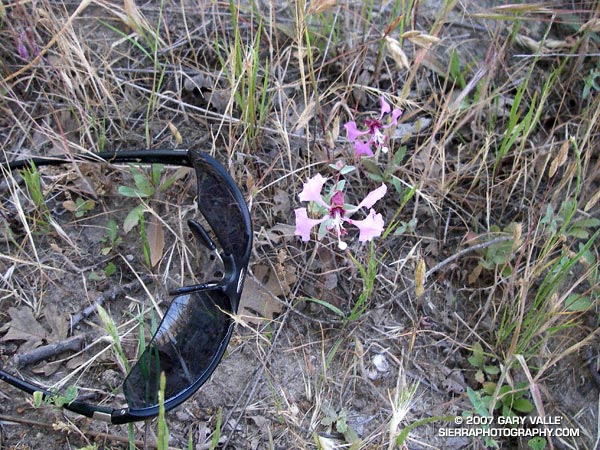
One of the best indicators of seasonal rainfall I’ve found in the oak woodland and chaparral areas of Southern California in which I run is Elegant Clarkia (Clarkia unguiculata). In a wet year it can grow more than 6 ft. tall. This year it is the shortest I’ve ever observed — about 5 inches in this photo taken near Lasky Mesa.
Related posts: Elegant Clarkia, Dealing With Drought
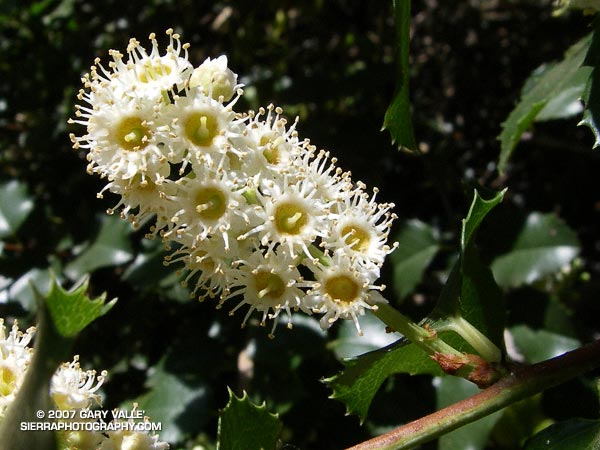
A closer look at the feathery blossoms of the holly-leaved cherry (Prunus ilicifolia) reveal a peculiar flower whose many stamens resemble the tentacles of a sea anemone.
Holly-leaved cherry is a member of the genus Prunus — the same as apricots, peaches, plums and cherries. As is the case with other species in this genus, the seed and leaves may contain hydrogen cyanide. It produces a small, thin-fleshed fruit favored by coyotes.
The photograph was taken on the slopes of Rivas Canyon near Will Rogers State Historic Park, while doing the route described in the post Will Rogers – Temescal Loop. Once again the weather for this (approximately) 21.5 mile loop was post-card perfect. A Google Earth image of a GPS trace of the route is available in the earlier post.
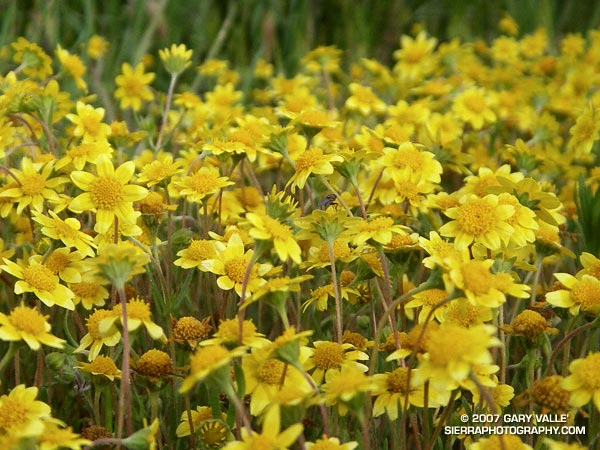
This photograph of goldfields (Lasthenia spp.) was taken on a run on Lasky Mesa in Upper Las Virgenes Canyon Open Space Preserve (formerly Ahmanson Ranch) almost exactly one year ago.
This April I haven’t seen any goldfields on Lasky Mesa. The soil is too dry for the seeds to germinate. The drought in Southern California has suppressed or delayed the growth of these, and many other species of wildflowers. This is one of the ways that annuals deal with drought — if the growing conditions aren’t appropriate, they don’t grow.
Black mustard, an invasive annual from Europe, is a hardy plant that is a good indicator of Winter rainfall. In 2005 and 2006 the mustard at Ahmanson Ranch was 6′ to 8′ tall and very widespread. This year its growth has been very limited, and the plants are diminutive in comparison.
Plants deal with drought in many other ways, such as dropping leaves, changing the leaf distribution, reducing the size of the leaf, changing the leaf orientation, modifying the shape of the leaf, or changing the leaf color. Flowering may be suppressed, or the flowering time shortened. In some cases the flower may be reduced, or viable fruit may not be produced. Branchlets or stems may be lost. Any life prolonging tactic may be employed when survival is at stake.
According to the NWS, if Los Angeles (USC) receives less than 1.95 inches of rain between now and June 30th, this water year (July 1, 2006 to June 30, 2007) will become the driest since recordkeeping began in 1877. At this point in the season, a new record seems more likely than not.
It was only 5 years ago (2001-2002) that Los Angeles experienced its driest water year so far, recording only 4.42 inches.
Related post: A Little Rain in Los Angeles